Preprint
Article
Modular Open-Source Design of Pyrolysis Reactor Monitoring and Control Electronics
Altmetrics
Downloads
148
Views
50
Comments
0
A peer-reviewed article of this preprint also exists.
Submitted:
24 October 2023
Posted:
26 October 2023
You are already at the latest version
Alerts
Abstract
Industrial pilot projects often rely on proprietary and expensive electronic hardware to control and monitor experiments. This raises costs and retards innovation. Open-source hardware tools exist for implementing these processes individually, however, they are not easily integrated with other designs. The Broadly Reconfigurable and Expandable Automation Device (BREAD) framework provides many open-source devices which can be connected to create more complex data acquisition and control systems. This article explores the feasibility of using BREAD plug-and-play open hardware to quickly design and test monitoring and control electronics for an industrial materials processing prototype pyrolysis reactor. Generally, pilot-scale pyrolysis plants are expensive custom designed systems. The plug-and-play prototype approach is first tested by connecting it to the pyrolysis reactor and ensuring it can measure temperature and actuate heaters and a stirring motor. Next, a single circuit board system was created and tested using the designs from the BREAD prototype to reduce the number of microcontrollers required. Both open-source control systems were capable of reliably running the pyrolysis reactor continuously and the overall cost of control was reduced by more than 10X. Open-source, plug-and-play hardware provides a reliable avenue for researchers to quickly develop data acquisition and control electronics for industrial-scale experiments.
Keywords:
Subject: Engineering - Electrical and Electronic Engineering
1. Introduction
Following the trend of accelerated innovation [1] that drove the success [2] of free and open source software [3], free and open source hardware (FOSH) [5,4] appears to be trailing adoption velocity by roughly 15 years [6]. An area of FOSH that has expanded rapidly is open source electronics [7]. This is readily observed by a rapidly expanding global library of low-cost and high-quality libre electronic designs for science equipment [8]. For example, outside of the expected open electronics for teaching electrical engineers [9,10], there are devices used to aid in electrical engineering research such as power monitoring [11] and phasor measurement [12]. Open source electronics systems have been developed to accurately measure gas pressures [13] and properties [14]. In addition, the approach has been used for such diverse and complex fields such as smart converters and cloud connectivity [15], medical devices [16] like those for neuroscience [17,18], conventional agriculture [19,20] and indoor agriculture [21], electrophoresis [22], nuclear physics [23] and environmental monitoring [24,25]. The latter in particular has enabled open-source platforms for doing research grade weather monitoring [26,27] and citizen environmental science [28,29]. In general, although open-source data acquisition (DAQ) systems have been developed for specific applications like wire arc additive manufacturing [30] or more general systems [31,32] the majority of science is still accomplished with closed source, proprietary systems. For example, National Instruments cDAQ [33] systems that are flexible, modular and operate as plug-and-play devices are widely popular but can be prohibitively expensive (~$1,000 USD for a chassis and from $138 USD to $2,846 USD per function card). Complex systems that need many actuators or sensors can cost tens of thousands of dollars. Such costs limit access to high-quality DAQ for those working in science and engineering in low-resource settings [34]. In many (maybe even most) cases the functions executed by the cDAQ cards could be carried out by an open-source alternative, however as desired function count increases, the simplicity of integrating the designs decreases substantially. To overcome this challenge a new open-source electronics platform with plug-and-play functionality has been developed called the Broadly Reconfigurable and Expandable Automation Device (BREAD) [35].
The BREAD framework also has potential to be used as a rapid prototyping platform for integrating open-source electronics into a larger, single circuit board control system. The performance and economic feasibility of such an approach has yet to be measured. To do this, a complex scientific and industrially relevant system is needed, and, in this study, a pyrolysis reactor was selected. Pyrolysis is a chemical recycling technology capable of converting waste plastic into their hydrocarbon components that can be sold as feedstock for new plastics production [36]. During pyrolysis, the plastic is thermally degraded at temperatures between 400-700 °C in an inert environment. By controlling key operating parameters such as temperature and vapor residence time, the reaction can be tuned to produce the desired hydrocarbon products ranging from gases (ethylene and propylene) to oils (gasoline and diesel range hydrocarbons) to waxes [37,38]. Both academic and industrial interest in plastic pyrolysis has increased in the past decade as a solution to the plastic waste crisis. Several pyrolysis pilot plants have been built across the world, ranging from scales of 1 kg/hr (small research lab [39]) to scales over 100 kg/hr (industrial [40,41]).
To test the capabilities of BREAD, an open source (OS) pyrolysis reactor control system was first prototyped with slices to control heating and stirring and to monitor temperature. After validating its performance, a single circuit board was designed and tested with the same pyrolysis reactor using the readily available circuit board designs from BREAD. Validation experiments included conducting a pilot scale pyrolysis experiment converting waste military polyolefin plastic into wax, oil, and gas product. BREAD was used in control the primary pyrolysis reaction for this experiment, which controls the product distribution by controlling the reaction temperature. Results are compared to a control experiment using a commercially available and proprietary controller with similar functionality to validate the OS controller performance.
2. Materials and Methods
2.1. Commercial Methods of Pyrolysis Reactor Control
The pilot pyrolysis reactor system (see Figure 1) is conventionally controlled with a commercial 1/8 DIN 7 Channel Universal Process Ramp & Soak Controllers available from Omega Engineering for US$1,123.50 [42]. This controller has the ability to provide ON/OFF and full PID control to 7 independent zones. Each zone can be programmed with a ramp/soak profile for heating or cooling outputs. Limitations of this controller include only being able to see one zone at a time, no recording of data, and no reprogramming the controller during an experiment without temporarily turning off the controller. The first two limitations make it extremely challenging to monitor temperature trends during an experiment, while the third makes it unsafe to adjust the setpoint of a control zone during an experiment.
There are other commercial controllers available that are reprogrammable and have temperature recording capabilities costs US$3,041-US$3,714 for 4 control zones [43]. This Model Quad Controller from KEM Scientific has accompanying computer software that is capable of recording temperature data and changing the setpoint during an experiment without having to turn off the controller.
2.2. Pyrolysis Reactor
The novel liquid-fed plastic pyrolysis system (invention disclosure at Michigan Technological University, Office of Innovation and Commercialization, Houghton, MI, USA) used in this work contains 3 major unit operations: dissolution tank, pyrolysis reactor, and series of condensers (see Figure 1). The dissolution tank uses a novel solvent to dissolve waste polyolefin plastic at 240 °C to produce a homogenous liquid feed [44]. This liquid feed is fed into the pyrolysis reactor at a maximum rate of 1 kg/hr, where primary pyrolysis occurs at 460 °C within heating zone 1. During primary pyrolysis, the polyolefin plastic is broken down into hydrocarbons of various chain lengths via a random scission reaction mechanism [45]. These hydrocarbon vapors, which are primarily high molecular weight waxes, flow into heating zone 2where they are further broken down into liquid and gas range hydrocarbons at 575 °C with a residence time of 1-3 seconds. The hydrocarbon waxes, liquids, and gases are collected in a dual condenser system, with the first condensing waxes at 150 °C and the second collecting liquid pyrolysis oil at 25 °C. Both condensers use compressed air as the cooling agent. Any inorganic fillers in the waste plastic (e.g., from U.S. military meals-ready-to-eat (MRE) polyethylene bags) that do not react are collected as char, where they are removed at the end of the experiment. The design, fabrication and operation, of this system was previously described in detail in Kulas et al. 2022 [39].[8]
2.3. Open-source Pyrolysis Reactor control system
To be successful for a wide range of pyrolysis systems, the control system needed to control seven heaters, a stirring motor, and monitor and log temperature at 11 different locations. To solve this problem, two slices from the BREAD framework were chosen: the DC motor slice (SLC_DCMT) and the relay heater slice (SLC_RLHT). The BREAD framework contains many open hardware designs which use Arduino Nano microcontrollers to communicate with an embedded Linux board like a Raspberry Pi via the Adafruit-PureIO package (Figure 2). Each slice is connected over an I2C bus, so the system can be expanded for more complex reactors by simply connecting more slices and assigning them a unique I2C address.
2.4. Hardware Specifications
Each relay heater slice could control a single heater (maximum of 10A @ 250VAC or 5A @ 30VDC) and monitor 2 k-type thermocouples and 2 thermistors (Figure 3). The DC motor slice could control the speed and direction of two DC motors (maximum of 3A @ 12V) (Figure 4). The 10-pin connector linked each slice to the loaf backplane, provided 12V power, and enabled I2C communication to the Raspberry Pi. Connecting the loaf to the Raspberry Pi was done via the I2C port (Figure 5 and Figure 6).
All PCB design files as well as the case models for slices and the loaf can be found in Table 1. All electrical components for each slice and loaf were sourced from Digikey and can be found in Table 2 to Table 4 with the total cost of the BREAD system in Table 5. The procedure for setting up a new slice is detailed in Appendix A.
2.5. Integrated Single-Board Design
To reduce costs and design more permanent control hardware, all components used with the BREAD system were integrated onto a single PCB (Figure 7). This reduced costs by eliminating the thermistor components and the additional motor control components. The new board could also control up to 10 heaters since it was not restricted to a maximum of 8 slices, like the BREAD system which used 7 SLC_RLHT and 1 SLC_DCMT. Arduinos 1-3 control three heaters and monitor three thermocouples. Arduino 4 controls heater 10 and thermocouples 10 and 11. Arduino 5 controls the DC motor. Each Arduino was treated like an individual slice with additional I/O and a unique I2C address. Thus, only minor additions to their firmware were needed (added additional heaters and thermocouples or removed additional motors). The slice definitions in the software were changed in a similar fashion.
As shown in Error! Not a valid bookmark self-reference., the cost of the single board design was greatly reduced when compared to the BREAD system.
2.6. Validation tests
The OS controller was used to control the temperature of heating zone 1 within the pyrolysis reactor during a pyrolysis experiment at 460 °C. The pyrolysis reaction was run for 80 minutes at a feed flow rate of 730 grams per hour. The feed composition for the reaction was 25% HDPE, 25% LDPE, and 50% pyrolysis wax solvent. The HDPE and LDPE was sourced from meals-ready-to-eat (MRE) plastic bags, a complex waste plastic that is not normally recycled. Results from the pyrolysis experiment were compared to an identical experiment conducted with the commercial controller used to control the primary pyrolysis reactor and all other process units.
3. Results
Three criteria were used to analyze the pyrolysis experiment and performance of the two controllers (commercial vs OS): temperature control, product yields, and product quality.
3.1. Pyrolysis Temperature Control
The temperature of the heating zone 1 (see Figure 1) was controlled at a setpoint of 460 °C during the pyrolysis reaction. For this control loop, the process variable is the heating zone 1 temperature (Figure 8) while the output is the power sent to the heating zone 1 heater. The controlled heater is a custom immersion cartridge heater (BriskHeat) located inside a cylindrical stainless-steel reactor. The temperature of heating zone 1 within the pyrolysis reactor is measured using a Type K thermocouple (Omega Engineering) located in the center of the reactor zone. The internal temperature of the immersion heater is monitored during the reaction as a safety precaution to ensure the control system is working as designed. A temperature difference of 100-150 °C between the heater and pyrolysis vapors is normal to allow heat transfer from the heaters to the heating zone. The controller functions by switching on a solid-state relay in pulses, supplying 120 V power to the heaters. Figure 8 compares the process variable for the two experiments compared to the setpoint. As expected, the commercial controller always keeps the process variable within ± 1-2 °C of the setpoint. The OS controller performs comparable to the commercial controller, with a slightly greater variation up to + 3 °C from the setpoint and a small negative bias of about 1 °C. This performance is well within the acceptable variation for the control system in this pyrolysis application. The OS controller was tuned using the Ziegler–Nichols method at 460 °C to determine the tuning constant for P-control [46].
3.2. Product Yields
Three products were produced during the pyrolysis experiment: hydrocarbon wax, oil, and gas. The wax and oil products were collected using a dual condenser system and are shown in Figure 9B. The oil product consists of primarily C6-C15 alkenes and is a yellow liquid at room temperature. The wax product consists of primarily C15-C30 alkenes and alkanes and is a tan solid at room temperature. A char residue is formed from the inorganic nanoclay filler material in the feed plastic (Figure 9A). Overall, the product distribution for the two pyrolysis experiments is remarkedly consistent (Figure 10). The OS controller produced 30.8 wt.% gas, 5.1 wt% liquid, 64.1 wt.% wax, and 1.6 wt.% char while the commercial controller produced 31.3 wt.% gas, 5.1 wt% liquid, 63.6 wt.% wax, and 1.6 wt.% char. This product distribution shown in Figure 10 validates the performance of the OS controller and proves it capable of controlling a complex scientific and industrially relevant process like pyrolysis.
3.3. Pyrolysis Product Quality
In addition to measuring product yields, the product quality of two collected products, wax and oil, was measured using gas chromatography-mass spectroscopy (GC-MS) (Thermo Scientific TRACE 1310 Gas Chromatograph in sequence with ITQ 110 Ion Trap MS). The methods for the GC-MS analyses have been previously published [39] and are capable of detecting alkanes, alkenes, and alkadienes from C6-C30. In this work, the GC-MS chromatograms for pyrolysis oil (Figure 11) and wax (Figure 12) are qualitatively compared for each controller. The pyrolysis oil produced by both controllers contains primarily alkenes from C6 to C15 (Figure 11) while the wax contains a mix of alkenes and alkanes from C15 to C30 (Figure 12). For both products, the chromatograms from each experiment are very similar, proving that the OS controller is capable of producing products with the same compositional quality as the commercial controller.
4. Discussion
4.1. Implications
The advantage of developing a single-board control system is fully realized under a mass production scale. BREAD allows researchers to rapidly produce reliable and inexpensive control hardware to test software, actuation, sensing, and control principles. Once a single-board design was fully validated it could be produced at scale for a fraction of the cost of a commercial system. The approximately equivalent commercial pyrolysis systems cost either $1,123.50 for 7 control channels (less functionality than the OS system) or $6,000 for 8 control channels (same functionality as OS system)[42,43]. The OS BREAD based system that can be built for under $350 integrated or under $580 as separated slices is more than a factor of ten savings and clearly makes pyrolysis control more accessible.
The use of open hardware is often related to cost savings when it replaces proprietary electronics for DAQ and control applications [4,7,47]. While BREAD-based DAQ systems are already significantly less expensive than proprietary systems like National Instruments cDAQ [33], custom open hardware like the pyrolysis system developed in this report further increase this cost difference when compared to proprietary pyrolysis reactor control systems. This is consistent with the open scientific hardware literature in general [48,49,50,8,51], in open source electronics [52,53,54], and in electronics for other chemical processes [55,56,57,58,59]. Compared to low-cost proprietary controllers the ease of BREAD and the functionality are clear. The limitations of these controllers of only being able to see one zone at a time, no re-cording of data, and no reprogramming the controller during an experiment without temporarily turning off the controller are all overcome. The BREAD-based OS system makes it easy to monitor temperature trends during an experiment and make changes just as high-cost proprietary tools. Finally, because of the system’s ability to log data and help students understand the pyrolysis process while also being low cost it can be used in education, which is also consistent with other open source electronics devices in the literature [60,61].
4.2. Limitations and Future Work
While a single circuit board decreases costs and improves reliability by permanently connecting all peripherals, it lacks ease of assembly. The integrated control system covered in this report took days to assemble by hand and had some design issues which needed to be fixed. Unfortunately, simple mistakes can be common when designing PCBs and they are not easily diagnosed until the board is fully assembled. Design iterations increase the cost and time to develop electronic hardware, so a BREAD-based design is more cost effective for experimentation and small-scale industrial applications.
There are several areas of future work that could improve the system. First, the connection reliability of BREAD slices could be improved and made more stable with 3-D printed supports for the electrical connections. This could be done by improving the ease of connection between slices and loafs by implementing some system to guide the 10-pin connector to the correct location. In addition, future work could focus on implementing a connection between LOAFs with additional 10-pin connectors to deliver power and communication. To make the systems easier to assemble the name of each slice could be integrated into the CAD of the case so they can be easily identified. These cases could also be improved to ensure the hex standoff does not loosen during assembly. Future work could also implement a mounting solution so any BREAD system can be sturdily fixed to a surface and wires organized to improve safety. Multiple versions of the same slice could also be developed with different components to aid in the component selection process during prototyping, particularly during supply chain disruptions. This would also eliminate delays due to any form of part shortages.
Finally, significant software adaptations could be made to improve ease of installation and provide an auto-tuning feature for PID control. Currently, the heaters are actuated with PID control which must be tuned by hand. It takes many hours to tune a heating system by hand and often the results are suboptimal. Having an auto-tune feature would improve ease of integration and could potentially lead to a more accurate controller when compared to commercial alternatives. The software could also be augmented to make the GUI easier for non-experts to use so that there would be a user operator screen and a research operator screen, with the former using default settings for standard production and the latter having complete control of the system.
5. Conclusions
This study assessed the performance of an open-source pyrolysis control system using plug-and-play hardware from the BREAD framework and compared this with a 7 channel Universal Process Ramp & Soak Controller from Omega Engineering. After performing a pyrolysis experiment and measuring the yield, the results indicate that the BREAD framework can be used to make comparable control hardware at a fraction of the cost of a commercial proprietary system. Like many other rapid prototyping technologies where small batches can be made more efficiently than with mass production processes, BREAD can be used as a rapid prototyping technology for electronic hardware.
The potential for BREAD to aid in PCB development was also explored by integrating the designs from BREAD Slices onto a single circuit board. While the final design further reduced the costs of the open-source controller, it took substantial time to assemble, which increased overall costs.
While a BREAD-based controller can provide additional functionality than the comparison systems, like data logging and the ability to change the temperature setpoint during an experiment, there are still some aspects which make BREAD more difficult to use. Improving these limitations, as outlined in future work, would make the BREAD framework a more competitive choice for researchers. Ultimately, the BREAD framework has the potential to serve as a rapid prototyping platform for control electronics and a starting point for researchers designing their own electronics.
Author Contributions
Conceptualization, J.M.P.; methodology, F.K.H., D.K., E.M., S.C., S.W. and J.M.P.; validation, F.K.H. D.K. and J.M.P.; formal analysis, F.K.H and D.K.; investigation, F.K.H. and D.K.; resources, J.M.P. and S.W.; data curation, F.K.H and J.M.P.; writing—original draft preparation, F.K.H., D.K., and J.M.P.; writing—review and editing, F.K.H., D.K., E.M., S.C., S. W., D.S., and J.M.P.; visualization, F.K.H and D.K.; supervision, J.M.P. and D.S.; project administration, J.M.P. and D.S.; funding acquisition, J.M.P and D.S.. All authors have read and agreed to the published version of the manuscript.
Funding
Funding for this work was provided by the Defense Advanced Research Projects Agency ReSource program cooperative agreement HR00112020033, the NSF SBIR Phase II grant number: 1746480, and the Thompson Endowment. The views, opinions and/or findings expressed are those of the authors and should not be interpreted as representing the official views or policies of the Department of Defense or the U.S. Government.
Data Availability Statement
Data is available upon request.
Conflicts of Interest
The authors declare no conflicts of interest.
Appendix A: Setting Up a New Slice
When adding a new slice to a network, the I2C address needs to be updated and the software must be told how to handle the new slice (i.e. specific commands, control program, etc.). Follow these steps to setup a new slice:
- Open the .ino file included in the Firmware folder for the slice’s specific repository.
- At the top of the program, change the I2C address to a number not used by the other slices in the network.
|
- 4.
- Connect the Arduino Nano via mini-USB cable to the computer.
- 5.
- Ensure the proper board, processor, and port are selected under “Tools”.
- 6.

- 7.
- Verify and upload the code.
- 8.

- 9.
- Connect the slice to the loaf backplane.
For each slice with a unique address, the software must be told how to handle both the sensors and actuators that may be connected to a slice. The relay heater slice is used as an example below:
- On the Linux board, open “devices.json”.
- Each thermocouple and thermistor can be added by defining their specific parameters in the DEVICES section (Table 7).
Table 7.
Sensor Setup Parameters.
| Parameter | Value | Description |
|---|---|---|
| name | “Thermo 1” | Device name. Referred to in CONTROLS section |
| address | 15 | I2C address of slice |
| unit | “C” | Data units sent by slice |
| form | “byte” | Data form sent by slice |
| req_msg | [84,1] | Specific message to request data. For thermocouple 1 this is “T” (in ASCII 0x84) followed by 1 |
| delay | 0.3 | Delay between readings in seconds |
| read_length | 4 | Number of bytes to read. Thermocouple data in float format (4 bytes) |
- The heater actuator is added by defining its parameters in the CONTROL section (Table 8).
Table 8.
Actuator Setup Parameters.
| Parameter | Value | Description |
|---|---|---|
| enabled | false | Starting configuration. Always set to false |
| input | 0 | Current sensor input |
| lastInput | 0 | Last sensor input |
| setPoint | 0 | Desired sensor input |
| kp | 0.1 | Proportional gain |
| ki | 0.03 | Integral gain |
| kd | 0.03 | Derivative gain |
| er | 0 | Difference between setPoint and input |
| thermocouple | 1 | Thermocouple monitoring heater temperature |
| control | “control.BREADheaterPID” | Python program for controlling heater |
- 2.
- Save “devices.json” after adding all sensors and actuators.
References
- Kogut, B.; Metiu, A. Open-Source Software Development and Distributed Innovation. Oxford Review of Economic Policy 2001, 17, 248–264. [Google Scholar] [CrossRef]
- Weber, S. The Success of Open Source. In The Success of Open Source; Harvard University Press, 2005; ISBN 978-0-674-04499-9. [Google Scholar]
- Robles, G.; Amor, J.J.; Gonzalez-Barahona, J.M.; Herraiz, I. Evolution and Growth in Large Libre Software Projects. In Proceedings of the Eighth International Workshop on Principles of Software Evolution (IWPSE’05); September 2005; pp. 165–174. [Google Scholar]
- Oberloier, S.; Pearce, J.M. General Design Procedure for Free and Open-Source Hardware for Scientific Equipment. Designs 2018, 2, 2. [Google Scholar] [CrossRef]
- Powell, A. Democratizing Production through Open Source Knowledge: From Open Software to Open Hardware. Media, Culture and Society 2012, 34, 691–708. [Google Scholar] [CrossRef]
- Pearce, J.M. Sponsored Libre Research Agreements to Create Free and Open Source Software and Hardware. Inventions 2018, 3, 44. [Google Scholar] [CrossRef]
- Oellermann, M.; Jolles, J.W.; Ortiz, D.; Seabra, R.; Wenzel, T.; Wilson, H.; Tanner, R.L. Open Hardware in Science: The Benefits of Open Electronics. Integrative and Comparative Biology 2022, 62, 1061–1075. [Google Scholar] [CrossRef]
- Pearce, J.M. Economic Savings for Scientific Free and Open Source Technology: A Review. HardwareX 2020, 8, e00139. [Google Scholar] [CrossRef]
- Pozo-Ruz, A.; Aguilera, F.D.T.; Moron, M.J.; Rivas, E. Power Electronics Open-Source Educational Platform. Journal of Power Electronics 2012, 12, 842–850. [Google Scholar] [CrossRef]
- Balid, W.; Abdulwahed, M.; Alrouh, I. Development of an Educationally Oriented Open-Source Embedded Systems Laboratory Kit: A Hybrid Hands-on and Virtual Experimentation Approach. The International Journal of Electrical Engineering & Education 2014, 51, 340–353. [Google Scholar] [CrossRef]
- Oberloier, S.; Pearce, J.M. Open Source Low-Cost Power Monitoring System. HardwareX 2018, 4, e00044. [Google Scholar] [CrossRef]
- Laverty, D.M.; Best, R.J.; Brogan, P.; Al Khatib, I.; Vanfretti, L.; Morrow, D.J. The OpenPMU Platform for Open-Source Phasor Measurements. IEEE Trans. Instrum. Meas. 2013, 62, 701–709. [Google Scholar] [CrossRef]
- Goertzen, L.; Mehr, N.; Lopez, M.; Udell, C.; Selker, J.S. Low-Cost and Precise Inline Pressure Sensor Housing and DAQ for Use in Laboratory Experiments. HardwareX 2020, 8, e00112. [Google Scholar] [CrossRef]
- Suriano, D. A Portable Air Quality Monitoring Unit and a Modular, Flexible Tool for on-Field Evaluation and Calibration of Low-Cost Gas Sensors. HardwareX 2021, 9, e00198. [Google Scholar] [CrossRef] [PubMed]
- Merenda, M.; Iero, D.; Pangallo, G.; Falduto, P.; Adinolfi, G.; Merola, A.; Graditi, G.; Della Corte, F.G. Open-Source Hardware Platforms for Smart Converters with Cloud Connectivity. Electronics 2019, 8, 367. [Google Scholar] [CrossRef]
- Pandey, G.; Vora, A. Open Electronics for Medical Devices: State-of-Art and Unique Advantages. Electronics 2019, 8, 1256. [Google Scholar] [CrossRef]
- Zimmermann, M.J.Y.; Maia Chagas, A.; Bartel, P.; Pop, S.; Prieto-Godino, L.L.; Baden, T. LED Zappelin’: An Open Source LED Controller for Arbitrary Spectrum Visual Stimulation and Optogenetics during 2-Photon Imaging. HardwareX 2020, 8, e00127. [Google Scholar] [CrossRef] [PubMed]
- Kimchi, E.Y.; Coughlin, B.F.; Shanahan, B.E.; Piantoni, G.; Pezaris, J.; Cash, S.S. OpBox: Open Source Tools for Simultaneous EEG and EMG Acquisition from Multiple Subjects. eNeuro 2020, 7, ENEURO.0212-20.2020. [Google Scholar] [CrossRef] [PubMed]
- Mesas-Carrascosa, F.J.; Verdú Santano, D.; Meroño, J.E.; Sánchez de la Orden, M.; García-Ferrer, A. Open Source Hardware to Monitor Environmental Parameters in Precision Agriculture. Biosystems Engineering 2015, 137, 73–83. [Google Scholar] [CrossRef]
- Botero-Valencia, J.S.; Mejia-Herrera, M.; Pearce, J.M. Low Cost Climate Station for Smart Agriculture Applications with Photovoltaic Energy and Wireless Communication. HardwareX 2022, 11, e00296. [Google Scholar] [CrossRef]
- Wishkerman, A.; Wishkerman, E. Application Note: A Novel Low-Cost Open-Source LED System for Microalgae Cultivation. Computers and Electronics in Agriculture 2017, 132, 56–62. [Google Scholar] [CrossRef]
- Lagos-Susaeta, D.; Salazar, O.; Asenjo, J.A. openPFGE: An Open Source and Low Cost Pulsed-Field Gel Electrophoresis Equipment. HardwareX 2020, 8, e00128. [Google Scholar] [CrossRef]
- Carena, F.; Carena, W.; Chapeland, S.; Chibante Barroso, V.; Costa, F.; Dénes, E.; Divià, R.; Fuchs, U.; Grigore, A.; Kiss, T.; et al. The ALICE Data Acquisition System. Nuclear Instruments and Methods in Physics Research Section A: Accelerators, Spectrometers, Detectors and Associated Equipment 2014, 741, 130–162. [Google Scholar] [CrossRef]
- Ferdoush, S.; Li, X. Wireless Sensor Network System Design Using Raspberry Pi and Arduino for Environmental Monitoring Applications. Procedia Computer Science 2014, 34, 103–110. [Google Scholar] [CrossRef]
- Poquita-Du, R.C.; Du, I.P.M.; Todd, P.A. EmerSense: A Low-Cost Multiparameter Logger to Monitor Occurrence and Duration of Emersion Events within Intertidal Zones. HardwareX 2023, 14. [Google Scholar] [CrossRef]
- Netto, G.T.; Arigony-Neto, J. Open-Source Automatic Weather Station and Electronic Ablation Station for Measuring the Impacts of Climate Change on Glaciers. HardwareX 2019, 5, e00053. [Google Scholar] [CrossRef]
- Woo, W.; Richards, W.; Selker, J.; Udell, C. WeatherChimes: An Open IoT Weather Station and Data Sonification System. HardwareX 2023, 13, e00402. [Google Scholar] [CrossRef] [PubMed]
- Camprodon, G.; González, Ó.; Barberán, V.; Pérez, M.; Smári, V.; de Heras, M.Á.; Bizzotto, A. Smart Citizen Kit and Station: An Open Environmental Monitoring System for Citizen Participation and Scientific Experimentation. HardwareX 2019, 6, e00070. [Google Scholar] [CrossRef]
- Nguyen, B.; Goto, B.; Selker, J.S.; Udell, C. Hypnos Board: A Low-Cost All-in-One Solution for Environment Sensor Power Management, Data Storage, and Task Scheduling. HardwareX 2021, 10, e00213. [Google Scholar] [CrossRef]
- Pringle, A.M.; Oberloier, S.; Petsiuk, A.L.; Sanders, P.G.; Pearce, J.M. Open Source Arc Analyzer: Multi-Sensor Monitoring of Wire Arc Additive Manufacturing. HardwareX 2020, 8, e00137. [Google Scholar] [CrossRef]
- Herbst, R.; Claus, R.; Freytag, M.; Haller, G.; Huffer, M.; Maldonado, S.; Nishimura, K.; O’Grady, C.; Panetta, J.; Perazzo, A. Design of the SLAC RCE Platform: A General Purpose ATCA Based Data Acquisition System. In Proceedings of the 2014 IEEE Nuclear Science Symposium and Medical Imaging Conference (NSS/MIC); IEEE: Seattle, WA, USA, November, 2014; pp. 1–4. [Google Scholar]
- Ferrero Martín, F.J.; Valledor Llopis, M.; Campo Rodríguez, J.C.; Blanco González, J.R.; Menéndez Blanco, J. Low-Cost Open-Source Multifunction Data Acquisition System for Accurate Measurements. Measurement 2014, 55, 265–271. [Google Scholar] [CrossRef]
- CompactDAQ Systems. Available online: https://www.ni.com/en-ca/shop/compactdaq.html (accessed on 15 June 2023).
- Maia Chagas, A. Haves and Have Nots Must Find a Better Way: The Case for Open Scientific Hardware. PLoS Biol 2018, 16, e3000014. [Google Scholar] [CrossRef]
- Oberloier, S.; Whisman, N.G.; Hafting, F.; Pearce, J.M. Open Source Framework for a Broadly Expandable and Reconfigurable Data Acquisition and Automation Device (BREAD). HardwareX 2023, 15, e00467. [Google Scholar] [CrossRef] [PubMed]
- Li, H.; Aguirre-Villegas, H.A.; Allen, R.D.; Bai, X.; Benson, C.H.; Beckham, G.T.; Bradshaw, S.L.; Brown, J.L.; Brown, R.C.; Cecon, V.S.; et al. Expanding Plastics Recycling Technologies: Chemical Aspects, Technology Status and Challenges. Green Chem. 2022, 24, 8899–9002. [Google Scholar] [CrossRef]
- Yadav, G.; Singh, A.; Nicholson, S.R.; Beckham, G.T. Techno-Economic Analysis and Life Cycle Assessment for Pyrolysis of Mixed Waste Plastics. In National Renewable Energy Lab.(NREL), Golden, CO (United States).
- Gracida-Alvarez, U.R.; Winjobi, O.; Sacramento-Rivero, J.C.; Shonnard, D.R. System Analyses of High-Value Chemicals and Fuels from a Waste High-Density Polyethylene Refinery. Part 1: Conceptual Design and Techno-Economic Assessment. ACS Sustainable Chem. Eng. 2019, 7, 18254–18266. [Google Scholar] [CrossRef]
- Kulas, D.G.; Zolghadr, A.; Shonnard, D.R. Liquid-Fed Waste Plastic Pyrolysis Pilot Plant: Effect of Reactor Volume on Product Yields. Journal of Analytical and Applied Pyrolysis 2022, 166, 105601. [Google Scholar] [CrossRef]
- Quantafuel Expands into the UK to Help Solve Plastic Waste Problem. Available online: https://interplasinsights.com/api/content/36fca3c0-1d0d-11ec-a329-1244d5f7c7c6/ (accessed on 19 October 2023).
- How Waste Solutions Company Brightmark Is Converting Plastic Waste into Fuel. Available online: https://brightmark.com/newsroom/business-insider-ashley/ (accessed on 19 October 2023).
- 1/8 DIN 4 and 7 Channel Universal Process Ramp & Soak Controllers. Available online: https://www.omega.com/en-us/control-monitoring/controllers/multiloop-controllers/cn1504-series/p/CN1507TC (accessed on 18 September 2023).
- Model Quad Four Independent Controllers | J-KEM. In J-Kem Scientific.
- Zolghadr, A.; Kulas, D.; Shonnard, D. Evaluation of Pyrolysis Wax as a Solvent in Polyolefin Pyrolysis Processing. Ind. Eng. Chem. Res. 2022, 61, 11080–11088. [Google Scholar] [CrossRef]
- Kulas, D.G.; Zolghadr, A.; Shonnard, D. Micropyrolysis of Polyethylene and Polypropylene Prior to Bioconversion: The Effect of Reactor Temperature and Vapor Residence Time on Product Distribution. ACS Sustainable Chem. Eng. 2021, 9, 14443–14450. [Google Scholar] [CrossRef]
- Åström, K.J.; Murray, R.M. Feedback Systems: An Introduction for Scientists and Engineers; Princeton University Press: Princeton, 2008; ISBN 978-0-691-13576-2. [Google Scholar]
- Karami, M.; McMorrow, G.V.; Wang, L. Continuous Monitoring of Indoor Environmental Quality Using an Arduino-Based Data Acquisition System. Journal of Building Engineering 2018, 19, 412–419. [Google Scholar] [CrossRef]
- Pearce, J.M. Building Research Equipment with Free, Open-Source Hardware. Science 2012, 337, 1303–1304. [Google Scholar] [CrossRef] [PubMed]
- Daniel K., F.; Peter J., G. Open-Source Hardware Is a Low-Cost Alternative for Scientific Instrumentation and Research. Modern Instrumentation 2012, 2012. [Google Scholar] [CrossRef]
- Pearce, J.M. Open-Source Lab: How to Build Your Own Hardware and Reduce Research Costs; Elsevier, 2013; ISBN 978-0-12-410486-0. [Google Scholar]
- Wenzel, T. Open Hardware: From DIY Trend to Global Transformation in Access to Laboratory Equipment. PLOS Biology 2023, 21, e3001931. [Google Scholar] [CrossRef]
- Costa, D.G.; Duran-Faundez, C. Open-Source Electronics Platforms as Enabling Technologies for Smart Cities: Recent Developments and Perspectives. Electronics 2018, 7, 404. [Google Scholar] [CrossRef]
- Rocha Ribeiro, R.; Bauer, E.; Lameiras, R. HIGROTERM: An Open-Source and Low-Cost Temperature and Humidity Monitoring System for Laboratory Applications. Inventions 2021, 6, 84. [Google Scholar] [CrossRef]
- Toldrà, A.; Ainla, A.; Khaliliazar, S.; Landin, R.; Chondrogiannis, G.; Hanze, M.; Réu, P.; Hamedi, M.M. Portable Electroanalytical Nucleic Acid Amplification Tests Using Printed Circuit Boards and Open-Source Electronics. Analyst 2022, 147, 4249–4256. [Google Scholar] [CrossRef]
- Grinias, J.P.; Whitfield, J.T.; Guetschow, E.D.; Kennedy, R.T. An Inexpensive, Open-Source USB Arduino Data Acquisition Device for Chemical Instrumentation. J. Chem. Educ. 2016, 93, 1316–1319. [Google Scholar] [CrossRef] [PubMed]
- Pearce, J. Impacts of Open Source Hardware in Science and Engineering. The Bridge 2017. [Google Scholar]
- Davis, J.J.; Foster, S.W.; Grinias, J.P. Low-Cost and Open-Source Strategies for Chemical Separations. Journal of Chromatography A 2021, 1638, 461820. [Google Scholar] [CrossRef]
- Urban, P.L. Universal Electronics for Miniature and Automated Chemical Assays. Analyst 2015, 140, 963–975. [Google Scholar] [CrossRef] [PubMed]
- Urban, P.L. Prototyping Instruments for the Chemical Laboratory Using Inexpensive Electronic Modules. Angewandte Chemie International Edition 2018, 57, 11074–11077. [Google Scholar] [CrossRef]
- Urban, P.L. Open-Source Electronics As a Technological Aid in Chemical Education. J. Chem. Educ. 2014, 91, 751–752. [Google Scholar] [CrossRef]
- Ngo, T.D. Open-Source Electronics Platforms: Development and Applications. Electronics 2019, 8, 428. [Google Scholar] [CrossRef]
Figure 1.
Process flow diagram of liquid-fed plastic pyrolysis. Waste polyethylene plastic enters the dissolution tank and is broken down in the primary and secondary pyrolysis reactors. A dual condenser system connects the wax, liquid, and gas product. MRE means meals-ready-to-eat bags. .
Figure 1.
Process flow diagram of liquid-fed plastic pyrolysis. Waste polyethylene plastic enters the dissolution tank and is broken down in the primary and secondary pyrolysis reactors. A dual condenser system connects the wax, liquid, and gas product. MRE means meals-ready-to-eat bags. .

Figure 2.
System connection diagram.
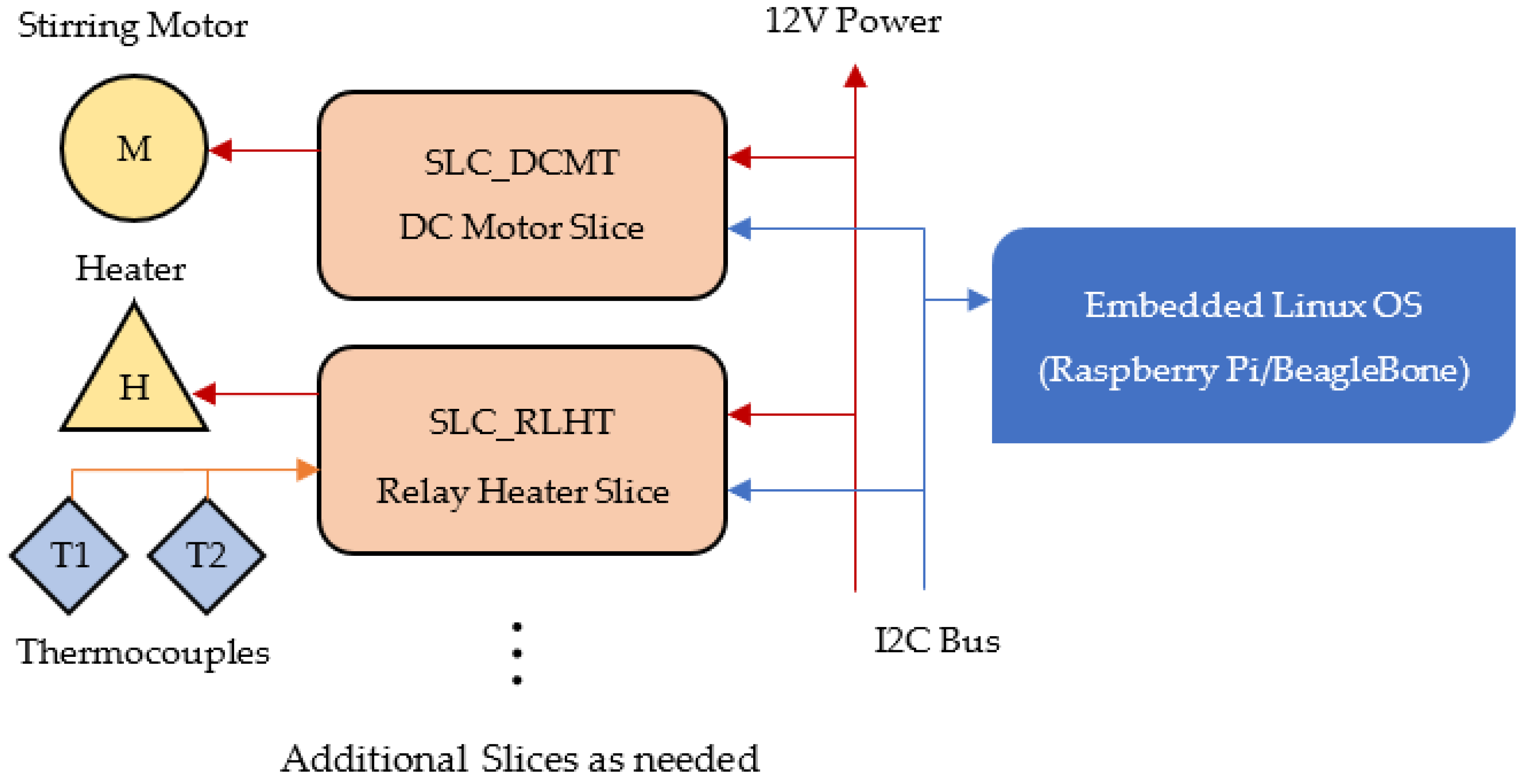
Figure 3.
SLC_RLHT Connection Diagram (When using the relay as a switch, only use input power and the normally closed [NC] output or the normally open [NO] output).
Figure 3.
SLC_RLHT Connection Diagram (When using the relay as a switch, only use input power and the normally closed [NC] output or the normally open [NO] output).
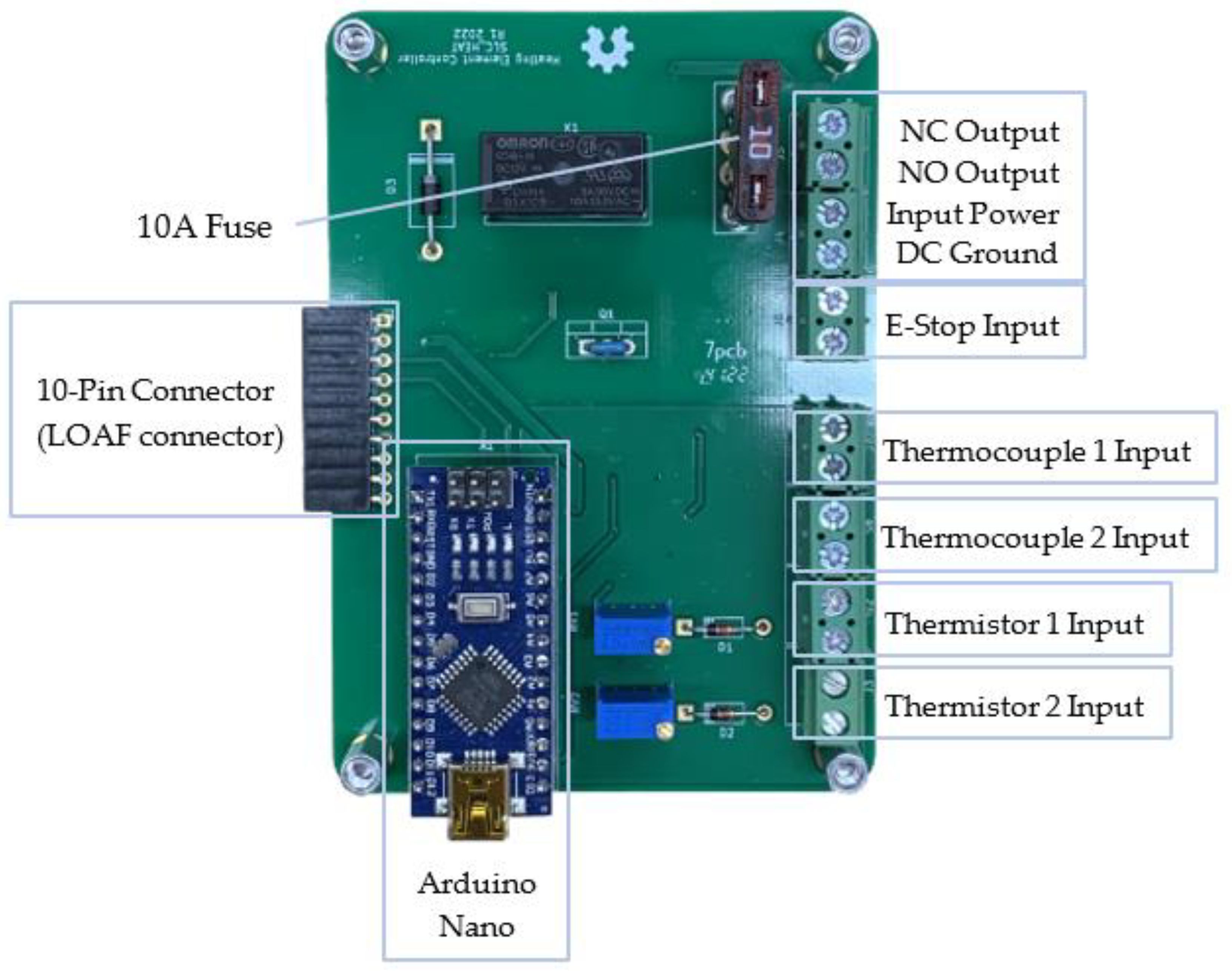
Figure 4.
SLC_DCMT Connection Diagram.
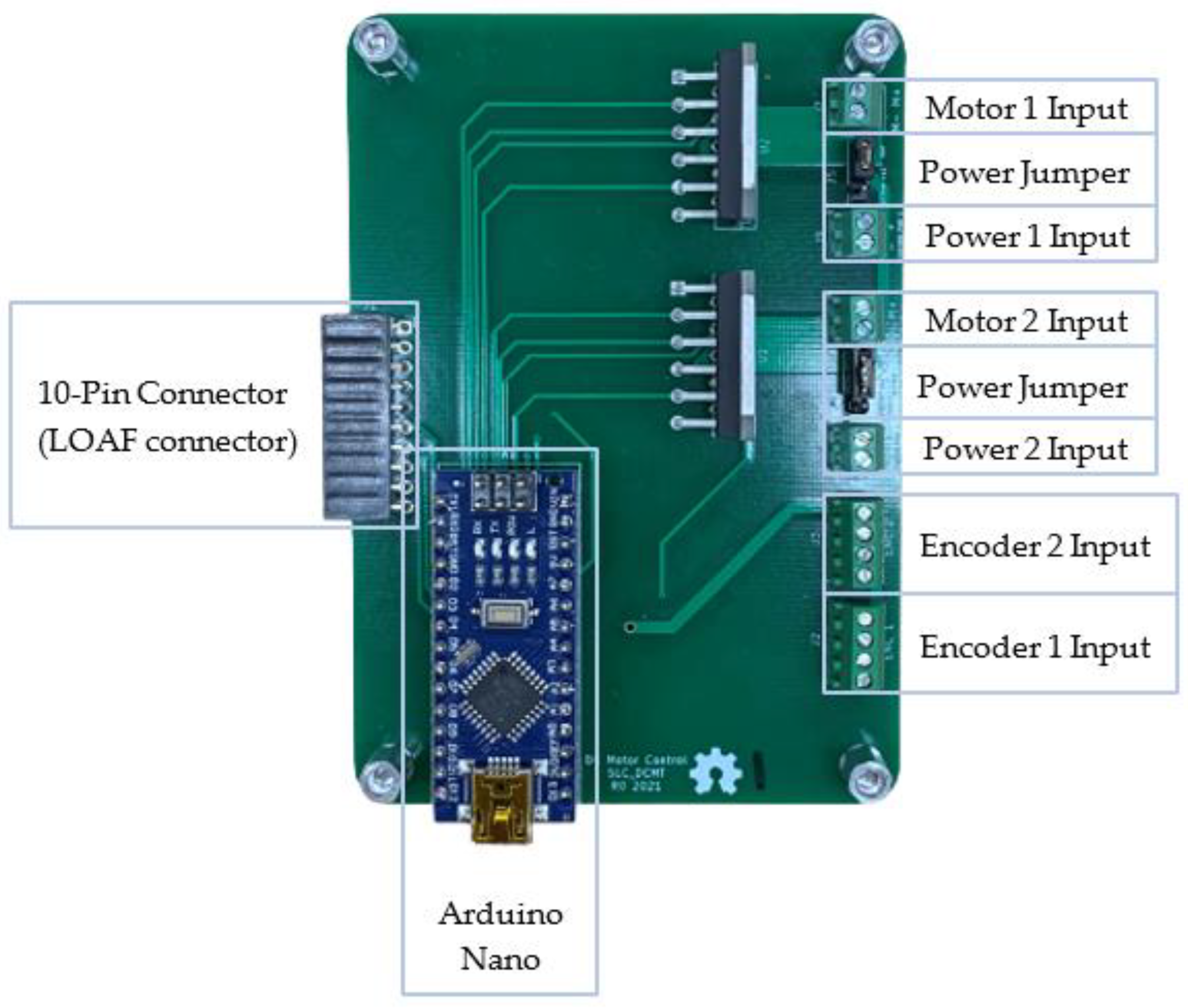
Figure 5.
LOAF Connection Diagram.
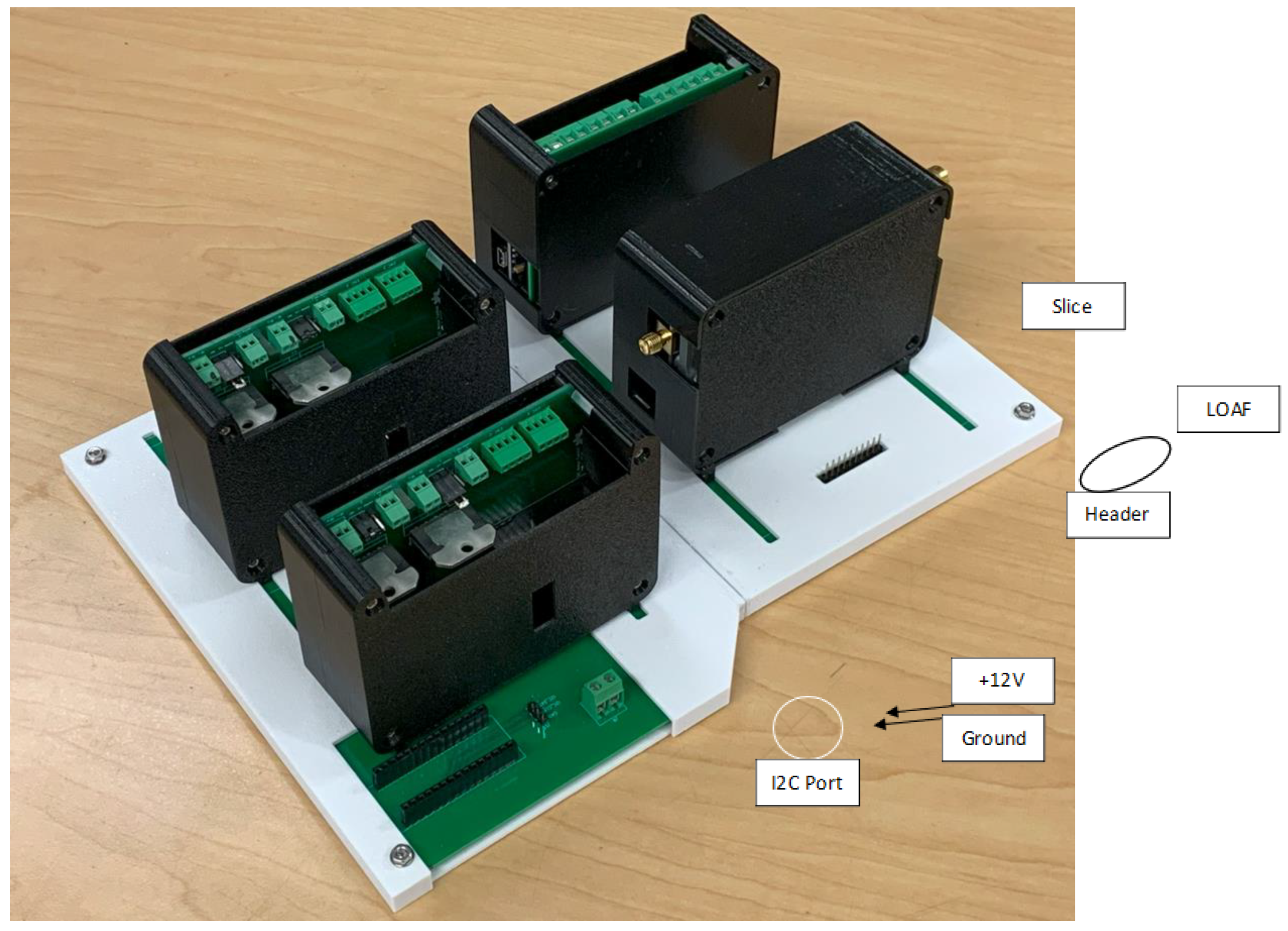
Figure 7.
Integrated Pyrolysis Board Connection Diagram.
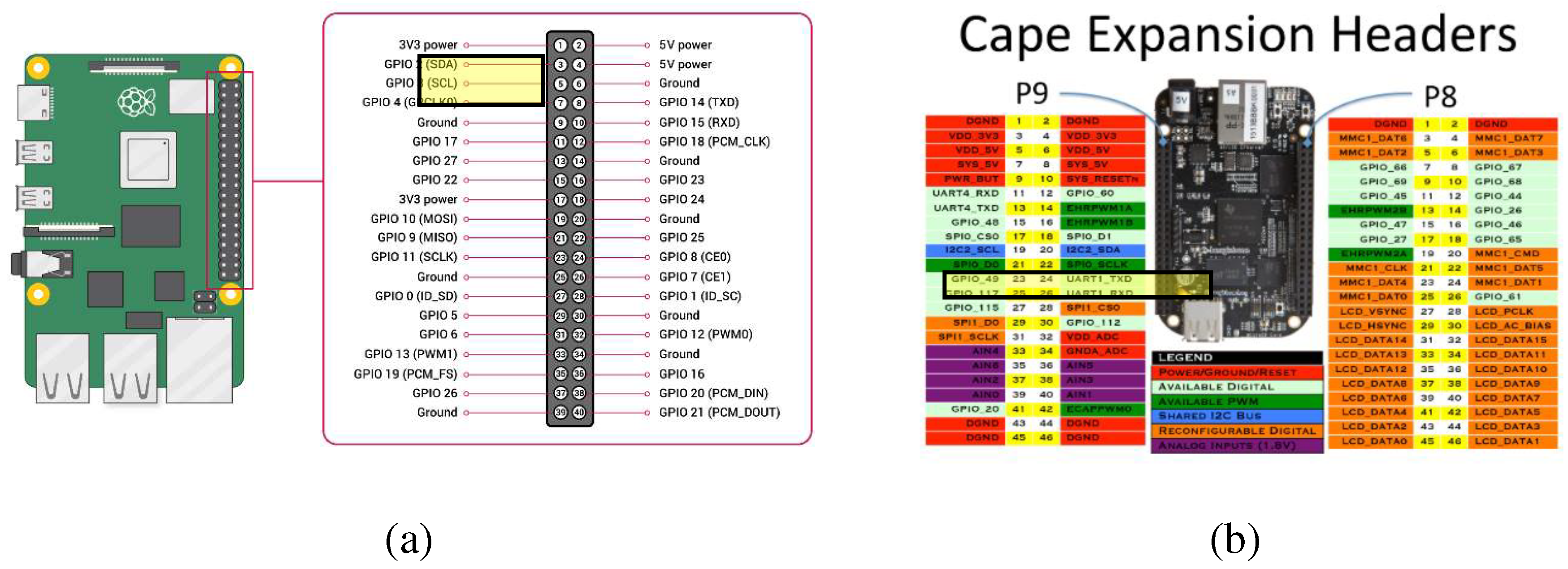
Figure 6.
Linux Board Connection Pins (highlighted in yellow): (a) Raspberry Pi; (b) Beaglebone Black.
Figure 6.
Linux Board Connection Pins (highlighted in yellow): (a) Raspberry Pi; (b) Beaglebone Black.
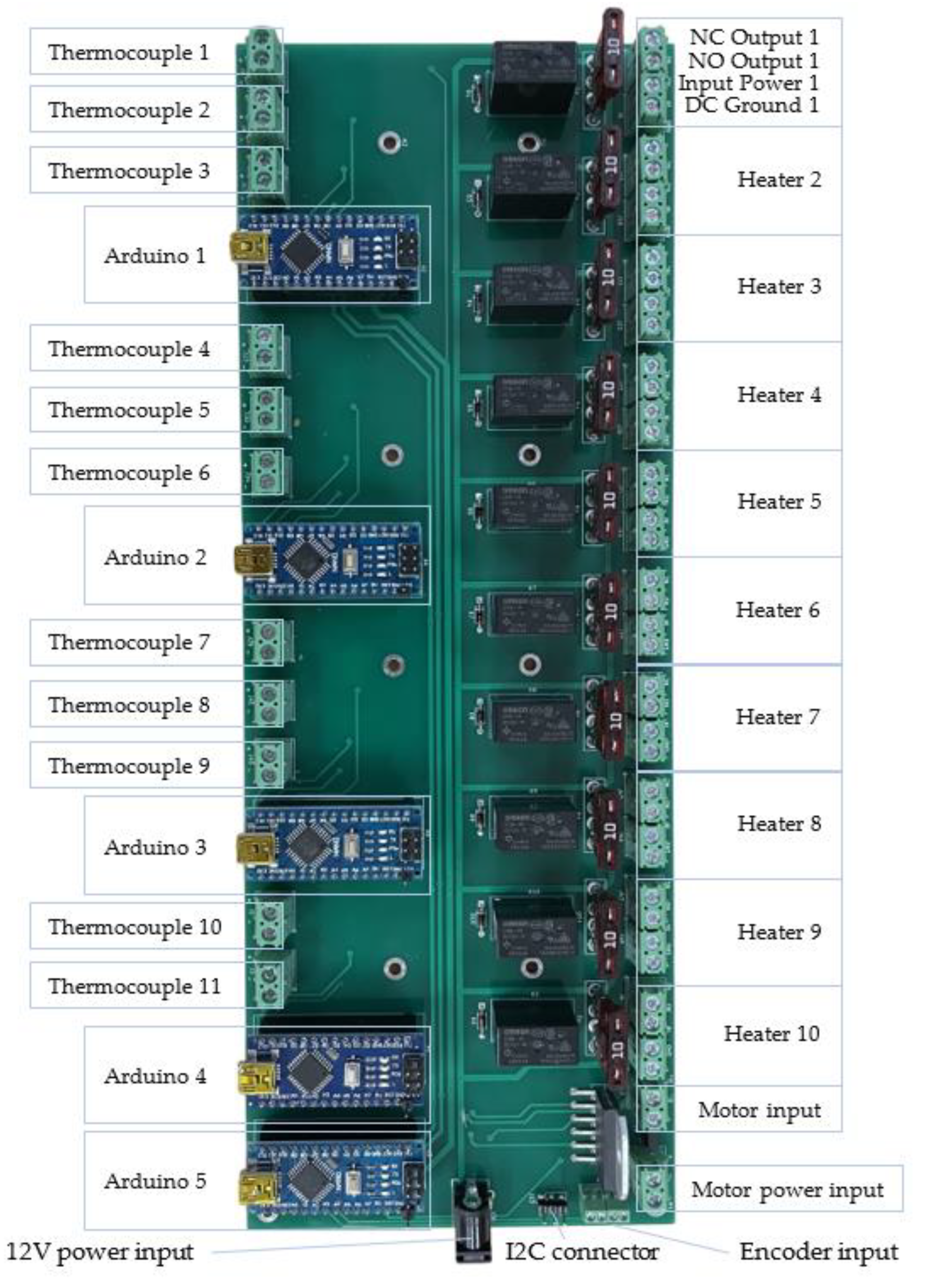
Figure 8.
Temperature traces for inside heating zone 1 of the pyrolysis reactor over an 80-minute pyrolysis reaction for both a commercial controller and the OS controller at identical operating conditions at a temperature setpoint of 460 °C and feed flow rate of 0.7 kg/hr.
Figure 8.
Temperature traces for inside heating zone 1 of the pyrolysis reactor over an 80-minute pyrolysis reaction for both a commercial controller and the OS controller at identical operating conditions at a temperature setpoint of 460 °C and feed flow rate of 0.7 kg/hr.
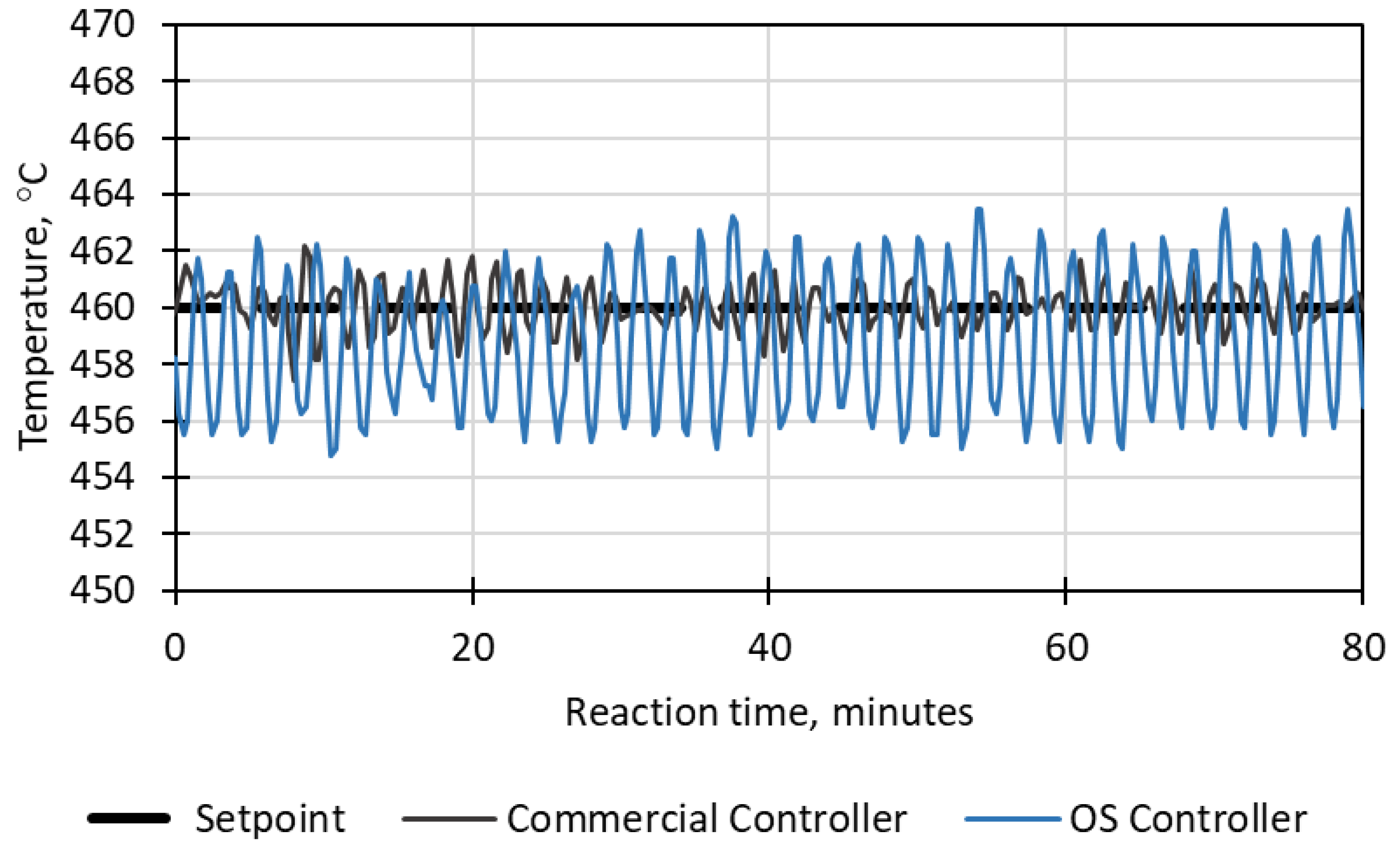
Figure 9.
Shredded waste MRE plastic (A) is broken down into oil (left B), wax (right B), and gas (not pictured).
Figure 9.
Shredded waste MRE plastic (A) is broken down into oil (left B), wax (right B), and gas (not pictured).
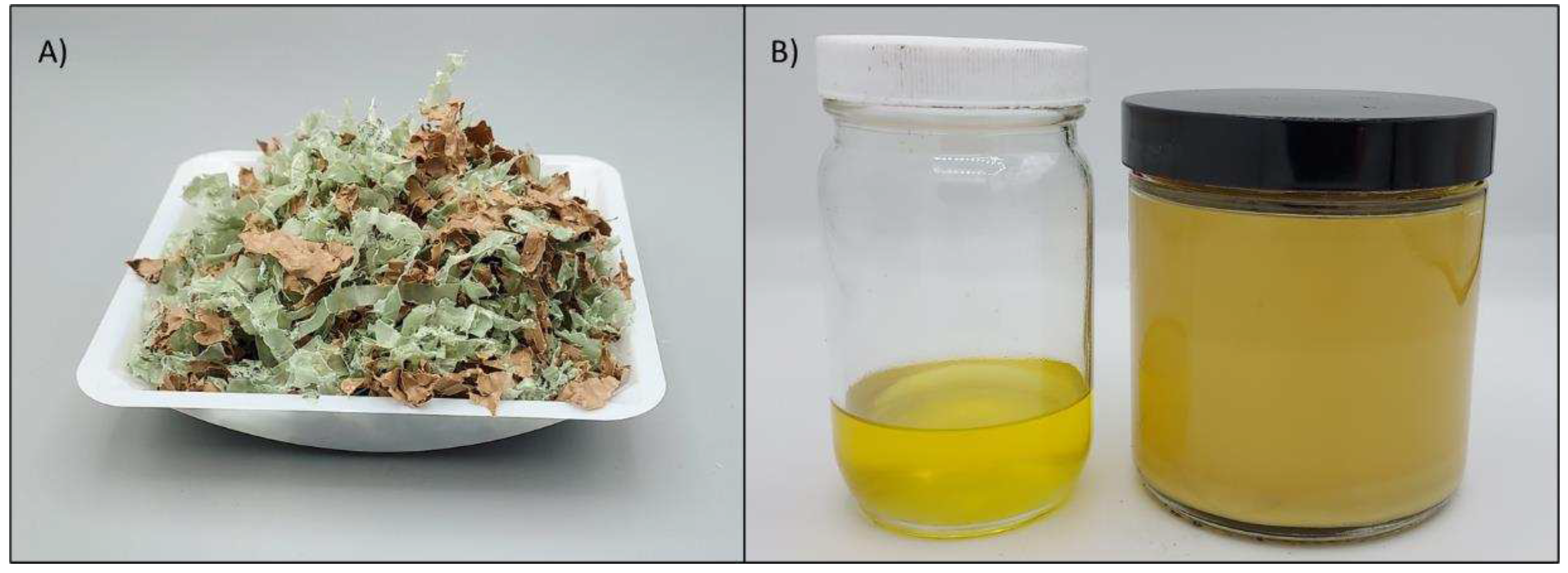
Figure 10.
Pyrolysis mass yields for experiments using OS and commercial controller.
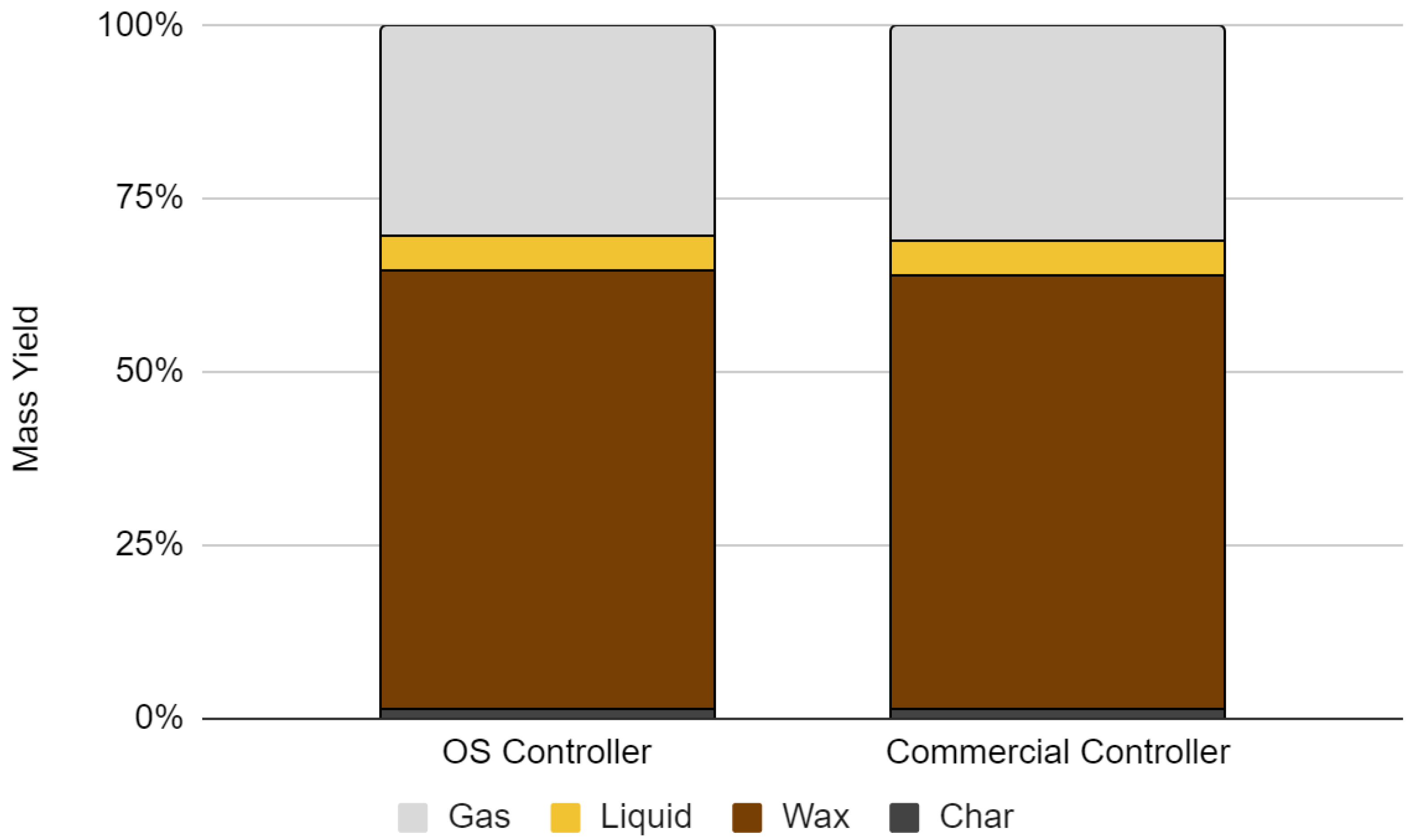
Figure 11.
GC-MS chromatogram of pyrolysis oil produced using OS control system (A) and commercial control system (B). Key peaks of interest are labeled while unlabeled peaks are one carbon number apart from each other.
Figure 11.
GC-MS chromatogram of pyrolysis oil produced using OS control system (A) and commercial control system (B). Key peaks of interest are labeled while unlabeled peaks are one carbon number apart from each other.
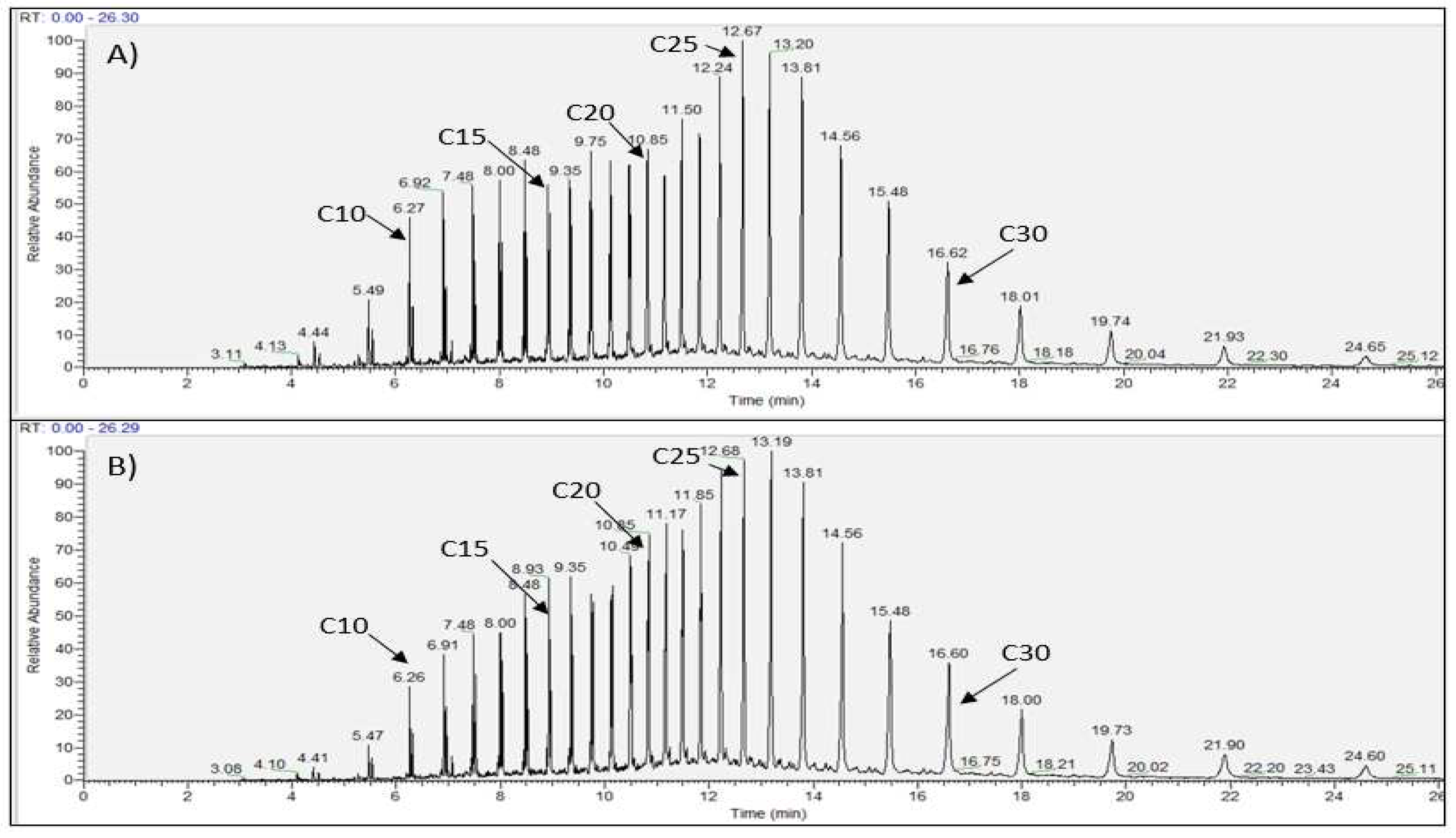
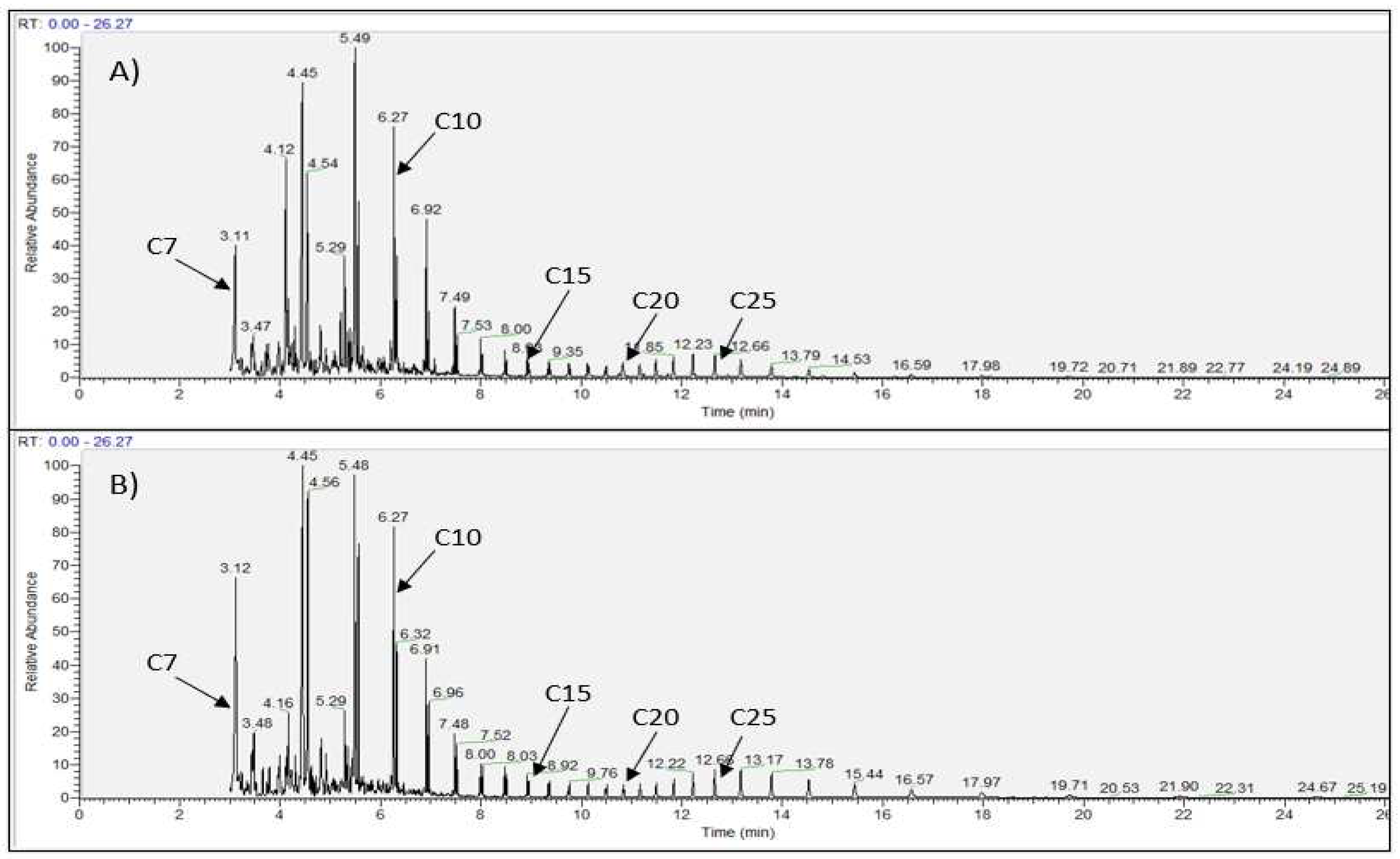
Figure 12.
GC-MS chromatogram of pyrolysis wax produced using OS control system (A) and commercial control system (B). Key peaks of interest are labeled while unlabeled peaks are one carbon number apart from each other.
Figure 12.
GC-MS chromatogram of pyrolysis wax produced using OS control system (A) and commercial control system (B). Key peaks of interest are labeled while unlabeled peaks are one carbon number apart from each other.
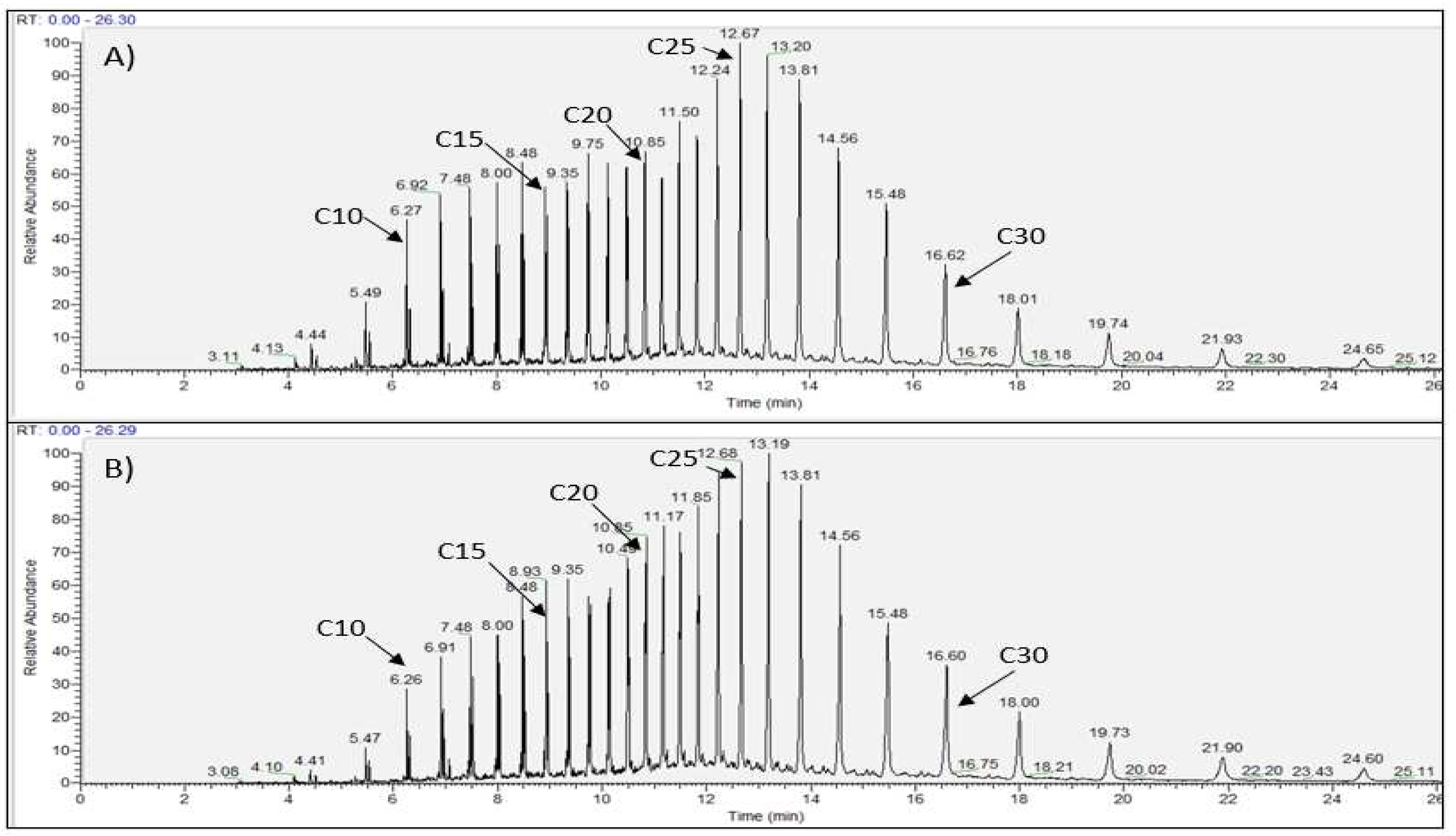
Table 6.
Integrated Board Bill of Materials (Cost in CAD, sourced from Digikey).
| Component | Number | Cost per unit | Total cost |
|---|---|---|---|
| Arduino Nano | 5 | $11.33 | $56.65 |
| Barrel Jack (12V 5A) | 1 | $1.18 | $1.18 |
| Capacitor 10nF | 14 | $0.27 | $3.78 |
| Capacitor 10uF | 3 | $0.81 | $2.43 |
| Diode | 10 | $0.14 | $1.40 |
| Fuse Holder 10A | 20 | $0.31 | $6.20 |
| 01x03 Male Header | 2 | $0.13 | $0.26 |
| Resistor 2.2k | 1 | $0.15 | $0.15 |
| Ferrite Bead | 22 | $0.40 | $8.80 |
| Relay SPDT 12V G5Q-1 | 10 | $2.30 | $23.00 |
| MAX6675ISA+ | 11 | $15.85 | $174.35 |
| TCMT1100 | 10 | $0.95 | $9.50 |
| AP1117-50 | 1 | $0.57 | $0.57 |
| LMD18200 | 1 | $29.71 | $29.71 |
| Screw Terminal 01x02 | 33 | $0.81 | $26.73 |
| Screw Terminal 01x04 | 1 | $2.00 | $2.00 |
| Automotive Fuse 10A | 1 | $1.64 | $1.64 |
| Total | $348.35 |
Table 1.
Design File Links .
| Files | URL |
|---|---|
| BREAD SLC_RLHT | https://osf.io/pf6gy/ |
| BREAD SLC_DCMT | https://osf.io/6aw9m/ |
| Integrated Pyrolysis Board | https://osf.io/3ugbn/ |
Table 2.
SLC_RLHT Bill of Materials (Cost in CAD, sourced from Digikey).
| Component | Number | Cost per unit | Total cost |
|---|---|---|---|
| Arduino Nano | 1 | $11.33 | $11.33 |
| Capacitor 10uF | 2 | $0.81 | $1.62 |
| Capacitor 10nF | 2 | $0.27 | $0.54 |
| Zener Diode 5.1V | 2 | $0.42 | $0.84 |
| Diode | 1 | $0.14 | $0.14 |
| Fuse Holder 10A | 2 | $0.31 | $0.62 |
| Ferrite Bead | 4 | $0.40 | $1.60 |
| Female Header 01x10 | 1 | $1.14 | $1.14 |
| Screw Terminal 01x02 | 6 | $0.81 | $4.86 |
| Relay SPDT 12V G5Q-1 | 1 | $2.30 | $2.30 |
| Resistor 10k | 4 | $0.15 | $0.60 |
| Potentiometer 10k | 2 | $3.73 | $7.46 |
| MCP6001U | 2 | $0.46 | $0.92 |
| MAX6675ISA+ | 2 | $15.85 | $31.70 |
| TCMT1100 | 1 | $0.95 | $0.95 |
| Automotive Fuse 10A | 1 | $1.64 | $1.64 |
| Total | $68.26 |
Table 3.
SLC_DCMT Bill of Materials (Cost in CAD, sourced from Digikey).
| Component | Number | Cost per unit | Total cost |
|---|---|---|---|
| Capacitor 10nF | 6 | $0.27 | $1.62 |
| LMD18200 | 2 | $29.71 | $59.42 |
| Arduino Nano | 1 | $11.33 | $11.33 |
| Resistor 2.2k | 2 | $0.15 | $0.30 |
| Screw Terminal 01x02 | 4 | $0.81 | $3.24 |
| 01x03 Male Header | 2 | $0.13 | $0.26 |
| Screw Terminal 01x04 | 2 | $2.00 | $4.00 |
| Capacitor 10uF | 4 | $0.81 | $3.24 |
| 01x10 Female Header | 1 | $1.14 | $1.14 |
| Total | $84.55 |
Table 4.
LOAF Bill of Materials (Cost in CAD, sourced from Digikey).
| Component | Number | Cost per unit | Total cost |
|---|---|---|---|
| 10uF | 2 | $0.81 | $1.62 |
| Arduino_Nano_v3.x | 1 | $11.33 | $11.33 |
| Conn_01x10_Male | 8 | $0.35 | $2.80 |
| Screw_Terminal_01x02 | 1 | $0.81 | $0.81 |
| Conn_01x03_Male | 1 | $0.13 | $0.13 |
| Total | $16.69 |
Table 5.
BREAD Pyrolysis System Cost (Cost in CAD).
| Component | Number | Cost per unit | Total cost |
|---|---|---|---|
| SLC_RLHT | 7 | $68.26 | $477.82 |
| SLC_DCMT | 1 | $84.55 | $84.55 |
| LOAF | 1 | $16.69 | $16.69 |
| Total | $579.06 |
Disclaimer/Publisher’s Note: The statements, opinions and data contained in all publications are solely those of the individual author(s) and contributor(s) and not of MDPI and/or the editor(s). MDPI and/or the editor(s) disclaim responsibility for any injury to people or property resulting from any ideas, methods, instructions or products referred to in the content. |
© 2023 by the authors. Licensee MDPI, Basel, Switzerland. This article is an open access article distributed under the terms and conditions of the Creative Commons Attribution (CC BY) license (http://creativecommons.org/licenses/by/4.0/).
Copyright: This open access article is published under a Creative Commons CC BY 4.0 license, which permit the free download, distribution, and reuse, provided that the author and preprint are cited in any reuse.
MDPI Initiatives
Important Links
© 2024 MDPI (Basel, Switzerland) unless otherwise stated







